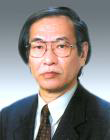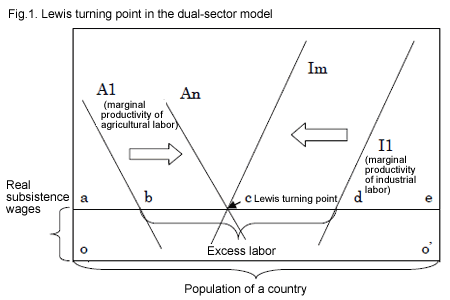Top>Opinion>Has China's Economy Already Passed the Lewisian Turning Point?
 Index
Index

Hiromi Yamamoto [profile]
Has China's Economy Already Passed the Lewisian Turning Point?
Hiromi Yamamoto
Specially Appointed Professor, Faculty of Economics, Chuo University
Areas of Specialization: Development Economics, Environmental Economics, East Asian Economic Theory
What is the Lewisian turning point?
One of the problems with China's economy that has recently gained a lot of attention is the debate around the Lewisian turning point of the Chinese economy. In terms of Development Economics, the Lewisian turning point is the equilibrium point at which the labor market of a developing nation moves from a state of labor surplus to that of labor shortage. The theory was founded in 1954 by W. A. Lewis, who went on to win the Nobel Prize in Economics in 1979. His dual economy model was further developed in 1961 by G. Ranis and J. C. H. Fei.
To explain it simply, the economy of a developing country is composed of an agricultural and an industrial sector, and surplus labor from the agricultural sector is absorbed into the industrial sector as the latter develops. The point at which this surplus labor is completely absorbed into the industrial sector is a turning point. To express this as a graph, with the horizontal axis showing the labor population of a country, take real subsistence wage line on the level. This indicates an unlimited supply of labor, the elasticity of which is infinite. We can then plot two curves, the agricultural sector's labor demand curve (the marginal productivity of agricultural labor) sloping downward to the right from the left vertical axis, and the industrial sector's labor demand curve (the marginal productivity of industrial labor) sloping downward to the left from the right vertical axis. The agricultural labor demand is decided when the agricultural labor demand curve intersects with the real subsistence wage line(the unlimited supply curve of labor). The industrial labor demand is also decided in the same way.
The central remaining portion when the agricultural and the industrial labor demand is subtracted from total workforce is the amount of surplus labor. This surplus labor is normally employed in the agricultural sector, and is in disguised unemployment within that sector. Technological progress shifts the agricultural labor demand curve to the right and the industrial labor demand curve to the left. The turning point is the point of equilibrium where the subsistence wage line intersects with the agricultural and industrial labor demand curves.

Expressing this in the above diagram, oo' indicates the population of a country and oa' its real subsistence wages. If A1 is the marginal productivity of agricultural labor and I1 the marginal productivity of industrial labor, the labor portion employed in agriculture is ab and that employed in the industrial sector is de, while the remaining bd is excess labor, or the disguised unemployed within the agricultural sector. With the progress of technology, I1 shifts leftwards m times to Im and A1 rightwards n times to An. Point c, the congruous point of equilibrium on the real wages line ae, is the Lewis turning point, at which excess labor completely disappears. Thereafter the labor market becomes labor deficient and real wages rise.
The debate about the Chinese economy's Lewisian turning point
Most China experts insisit that the country's economy has already passed the turning point around 2004. However, most analyses for this problem are inadequate in terms of economics. Their basis is on changes in the urban labor market and changes in population structure, for example. There are research papers estimating the marginal productivity of labor in the agricultural sector, and those comparing the marginal productivity of agricultural labor with subsistence wage levels, but there are problems with the accuracy of the data used in some cases. On the other hand, some Japanese academics argue that the turning point has not yet been reached, such as Professor Emeritus Ryoshin Minami at Hitotsubashi University (2009) and Professor Tomoo Marukawa at the University of Tokyo (2010). Both Professor Minami and Professor Marukawa have estimated the Cobb-Douglas production function of Chinese agriculture, but the problem with the Chinese agricultural data they used is that it includes a wide range of data not only from agriculture but also from forestry, animal husbandry, and fishery. The same problem exists with the production function analyses of Chinese researchers who use the same kind of data.
Our research
Dr. Mitsuo Inada of Kyoto University and I (2010, 2012) estimated the Cobb-Douglas production function using as our panel data the production cost data on Japonica rice (non-glutinous rice) collected from different provinces from 1992 to 2009 in National Agricultural Product Cost Survey edited by Price Department of State Development and Reform Commission.
Rice production volumes of explained variables were those of seven provinces: Liaoning, Jilin, Heilong, Jiangsu, Anhui, Henan, and Ningxia. The explanatory variables were agricultural working hours, capital services, and sown areas. The data that we focused on within this Cost Survey was labor input data. Although the input data conventionally used to estimate production function was the stock variable of worker numbers, the labor input data in this material was expressed by the unit of flow, 'gong fen'. The equation for converting this gong fen into working hours was not shown for a long time, but in the 2005 edition of National Agricultural Product Cost Survey it was clarified for the first time by the conversion rate of 1 gong fen to 8 hours. Previous production function analyses showed a downward bias in which coefficients of the production elasticity of the labor input variable became negative values, because the flow variable of agricultural production is an explained variable, while the stock variable of worker numbers is an explanatory variable. That is to say, an irrational result was generated with the negative marginal productivity of labor. It is natural that using a labor input variable as a flow variable rather than a stock variable in the estimation of production function should be fundamental for scientific calculation. This is what is called a matter of dimension in physics. Looking at the measurement results, we could estimate positive values for coefficients of the production elasticity of agricultural labor which were statistically significant.
Conclusion
From this measurement, the results of comparing the marginal productivity of agricultural labor with real market wages prove that the former are lower than the latter in each province. In other words, it is clear that the turning point has yet to be reached in these seven provinces. This is sufficient evidence to refute the opinion that the Chinese economy has already passed the turning point.
Although the Chinese government has been implementing a policy of reform and openness since 1979, it basically forbade the migration of peasants to urban areas. The family registers of peasants were not allowed to be incorporated into city family registers. In 1984, people's communes were decollectivized nationwide, and peasants started to work under the production contract system, and at last under the management contract system. At first, the government adopted a 'li tu bu li' (shift from agriculture without migration from a village) policy which forbade peasants in open unemployment under the management contract system to leave their villages even if they left their own farmland. However, urban demand for labor increased as the economy developed, and peasants in fact began to migrate to work in cities as 'nong min gong'(peasant workers). Without the labor of these peasant workers, construction of the infrastructure for the Beijing Olympics and Shanghai Expo would not have been completed. The 12th Five-Year Plan (2011-2015) included measures for turning peasant workers who had lived in cities for a certain number of years and their families into city residents.
Further mitigation policies on the peasant family register problem were gradually brought in during the 1990s, but in March 2001 the Ministry of Public Security published "Views on the Promotion of Reforms to the Family Register Management System in Small Cities and Towns." Then, in the 10th Five-Year Plan (2001-2005), it was declared that migration of peasants to small cities and towns would be actively promoted. Furthermore, the 11th Five-Year Plan (2006-2010) encouraged settlement of peasants in small- to medium-sized cities, and the 12th Five-Year Plan announced further relaxation policies on such settlement requirements. However, government policy forbidding the migration of peasants to large cities remains as firm as ever. In 2011, China's urban population finally overtook its rural population. Urban migration of the peasant workforce will continue to increase in the future and will never stop.
■References
- Inada, Mitsuo, and Hiromi Yamamoto, "The Economic Turning Point in the Chinese Economy: Evidence from Provincial Panel Data of Chinese Japonica Rice Cultivation,"(in Japanese), Journal of Chinese Economic Studies, Vol.9 No.1 (March 2012), pp.1-22.
- Inada, Mitsuo, and Hiromi Yamamoto, Analysis of Migration Decisions of Chinese Japonica Rice Farmers, Discussion Paper Series No. 145(2010), Institute of Economic Research, Chuo University.
- Hiromi Yamamoto
Specially Appointed Professor, Faculty of Economics, Chuo University
Areas of Specialization: Development Economics, Environmental Economics, East Asian Economic Theory - Professor emeritus, Kyoto University. Born in Tokushima Prefecture in 1945. He graduated in 1970 from the department of Agricultural and Forestry Economics, the Faculty of Agriculture, Kyoto University before withdrawing from the doctoral course in Agricultural and Forestry Economics in the same university's Graduate School of Agriculture. He received a PhD in Agricultural and Forestry Economics from Kyoto University in 1992. He served as a researcher at the Institute of Developing Economies under the auspices of the Ministry of International Trade and Industry, as a visiting fellow at the Centre of Asian Studies, University of Hong Kong, as a visiting fellow at the Institute of Contemporary Chinese Studies, the School of Oriental and African Studies, University of London, and as Professor at the Graduate School of Economics, Kyoto University before taking up his current position as Specially Appointed Professor on the Faculty of Economics at Chuo University in 2009. His major publications include China's Agricultural Policies During Its Period of Reform and Openness, Kyoto University Press, 1999.(in Japanese)
- Research Activities as a Member of Research Fellowship for Young Scientists (DC1), Japan Society for the Promotion of Science (JSPS) Shuma Tsurumi
- Important Factors for Innovation in Payment Services Nobuhiko Sugiura
- Beyond the Concepts of Fellow Citizens and Foreigners— To Achieve SDGs Goal 10 “Reduce Inequality Within and Among Countries” Rika Lee
- Diary of Struggles in Cambodia Fumie Fukuoka
- How Can We Measure Learning Ability?
—Analysis of a Competency Self-Assessment Questionnaire— Yu Saito / Yoko Neha - The Making of the Movie Kirakira Megane








